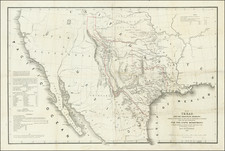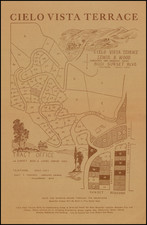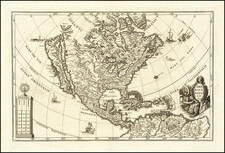Mapping The Rains of March 1938
Rare rainfall map of Southern California, published by the US Geological Survey, illustrating the rainfall which caused the catastrophic flooding in the winter of 1938.
The map was prepared to accompany the US Department of the Interior's 400 page report on the Floods of March 1938, prepared in cooperation with the Federal Emergency Administration of Public Works and Works Progress Administration.
The Floods of March 1938 in Southern California fundamentally altered the region's approach to urban planning and environmental management. In the late winter of 1938, a series of intense storms hit Southern California, culminating in one of the worst natural disasters in the region's history. Between February 27 and March 3, 1938, these storms brought an extraordinary volume of rain to the area. Los Angeles, for instance, recorded approximately 10 inches of rain during this period, a significant anomaly considering the city's average annual rainfall of 15 inches. This extreme weather event was part of a larger pattern affecting much of the Pacific coast.
The impact of this heavy rainfall was most acutely felt in the counties of Los Angeles, Riverside, Orange, and San Bernardino. The Los Angeles River and the Santa Ana River, along with their tributaries, were quickly overwhelmed by the deluge. In the Los Angeles basin, the river transformed into a raging torrent, causing widespread flooding, particularly in low-lying areas.
The consequences of these floods were severe. Over 5,000 homes were destroyed or severely damaged, and the infrastructure of the region, including roads, bridges, and utility lines, suffered extensive damage. The floods resulted in the tragic loss of approximately 115 lives. In financial terms, the damage was estimated at around $78 million in 1938 dollars (equivalent to over $1 billion today), making it one of the costliest natural disasters in the United States at that time.
The floods also led to significant environmental changes. The heavy flow of water caused substantial erosion and altered the landscapes of many river basins. In agricultural areas, particularly in Orange County, the floodwaters inundated farms, leading to considerable crop losses and soil erosion.
In response to this disaster, there was a marked shift in regional policies and practices regarding water management and flood control. The Federal and local governments initiated extensive flood control projects, including the construction of dams, reservoirs, and concrete river channels. These projects were aimed at preventing future floods of a similar magnitude. This response marked the beginning of a new era in Southern California's approach to environmental management, emphasizing the control and regulation of natural waterways.
An isohyetal map is a type of cartographic representation used in meteorology and hydrology to illustrate the spatial distribution of precipitation over a specific area and time period. The term "isohyetal" is derived from two Greek words: "isos" meaning equal, and "hyetos" meaning rain. Essentially, an isohyetal map is a rainfall map.
Key characteristics and functions of isohyetal maps include:
-
Contour Lines (Isohyets): The map features lines called isohyets, each of which connects points that received equal amounts of precipitation during a defined period. These lines are analogous to contour lines on a topographic map which connect points of equal elevation.
-
Spatial Distribution of Rainfall: By showing areas enclosed by each isohyet, these maps visually represent how much precipitation fell in different areas. This is particularly useful for understanding the spatial variability of rainfall in a region.
-
Temporal Scope: The data can cover various time scales, from a single storm event to longer periods like a month, season, or year.
-
Data Sources: The precipitation data used to create isohyetal maps can be gathered from various sources, including weather stations, rain gauges, and, in more recent developments, satellite observations.
-
Applications: These maps are valuable in fields such as agriculture, water resource management, flood forecasting, and climatology. They help in understanding and analyzing precipitation patterns, which is crucial for planning and managing water resources, agricultural practices, and responding to weather-related disasters.
-
Accuracy and Resolution: The accuracy and detail of an isohyetal map depend on the density and distribution of the data sources (rain gauges, for instance) and the methodology used to interpolate between these points.
Isohyetal maps are an essential tool for meteorologists, hydrologists, environmental scientists, and urban planners, providing a clear and concise way to visualize and analyze precipitation data over a geographical area.









![[ Used by '49ers To Travel To California ] Map of Oregon and Upper California from the surveys of John Charles Fremont and others authorities drawn by Charles Preuss 1848](https://storage.googleapis.com/raremaps/img/small/100557.jpg)

![(Southern California Aerial Photographs) [Collection of 9 Aerial Photographs of San Fernando Valley, Van Nuys, and Burbank]](https://storage.googleapis.com/raremaps/img/small/94783.jpg)

![[ California Petroleum ] A Description of the Recently Discovered Petroleum Region in California. With a Report on the Same [with:] Map Representing Locality of The Ojai Ranch in Santa Barbara County, California, belonging to the California Petroleum Company 1865](https://storage.googleapis.com/raremaps/img/small/103844.jpg)
